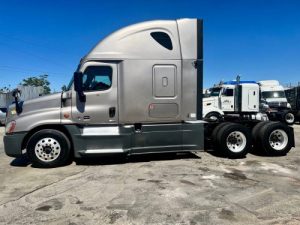Electric Semi Trucks For Sale: Navigating the Future of Freight
Electric Semi Trucks For Sale: Navigating the Future of Freight cars.truckstrend.com
The roar of diesel engines has long been synonymous with the arteries of global commerce, but a seismic shift is underway. Across highways and distribution centers, a new, quieter, and cleaner breed of heavy hauler is emerging: the electric semi truck. For businesses and owner-operators alike, the phrase "Electric Semi Trucks For Sale" is no longer a futuristic concept but a tangible opportunity, signaling a pivotal moment in logistics. This comprehensive guide delves into what it means to purchase an electric semi truck today, exploring the market, the benefits, the challenges, and the actionable steps to electrify your fleet.
The transition to electric heavy-duty vehicles is driven by a confluence of factors: escalating fuel costs, increasing environmental regulations, corporate sustainability goals, and rapid advancements in battery technology. Acquiring an electric semi truck isn’t merely a vehicle purchase; it’s an investment in a more sustainable, cost-efficient, and future-proof operation. It promises not just reduced emissions but also significant operational savings, a quieter work environment, and a stronger brand image in an increasingly eco-conscious world.
Electric Semi Trucks For Sale: Navigating the Future of Freight
The Dawn of Electric Heavy Haulage: Why Buy Now?
The market for electric semi trucks is rapidly maturing, offering compelling reasons for businesses to consider electrification. The benefits extend far beyond simply being "green."
Key Benefits of Electric Semi Trucks:
- Environmental Impact: Zero tailpipe emissions mean a drastic reduction in greenhouse gases and local air pollutants, contributing to cleaner air in urban areas and helping companies meet stringent environmental regulations and their own sustainability targets.
- Economic Savings:
- Fuel Costs: Electricity is significantly cheaper and less volatile in price than diesel. While charging costs vary by region and time of day, they consistently offer substantial savings per mile.
- Maintenance: Electric powertrains have far fewer moving parts than internal combustion engines, leading to reduced maintenance needs. No oil changes, fewer brake pad replacements (due to regenerative braking), and simpler systems translate to lower labor and parts costs.

- Operational Advantages:
- Performance: Electric motors deliver instant torque, providing powerful acceleration and superior responsiveness, which can be advantageous in stop-and-go urban driving or for climbing grades.
- Noise Reduction: Electric trucks operate much more quietly, improving driver comfort, reducing noise pollution in communities, and potentially allowing for extended delivery hours in noise-sensitive areas.
- Driver Experience: A smoother, quieter ride, combined with less vibration, can lead to reduced driver fatigue and improved retention in a competitive industry.

- Brand Image & Compliance: Operating electric trucks enhances a company’s public image as an environmentally responsible entity, which can be a strong selling point for customers and employees. It also prepares businesses for future regulations like Low Emission Zones (LEZs) or Zero Emission Zones (ZEZs) that are becoming more common globally.

Understanding the Market: Types and Key Specifications
The "Electric Semi Trucks For Sale" landscape is expanding, with several major manufacturers offering or soon-to-be-offering production models. These vehicles are primarily categorized by their Gross Vehicle Weight Rating (GVWR) and intended application. While medium-duty electric trucks (Class 5-7) are becoming common for last-mile delivery, the focus for "semi trucks" is on Class 8 heavy-duty vehicles designed for regional haul and, increasingly, long-haul operations.
Prominent Models and Types:
- Regional Haul: Trucks designed for shorter, predictable routes (e.g., 100-300 miles round trip). These often feature smaller battery packs but benefit from more frequent depot charging. Examples include the Volvo VNR Electric, Freightliner eCascadia (earlier versions), and Lion Electric Lion8.
- Long Haul: Emerging models targeting longer distances, requiring larger battery capacities and faster charging capabilities. The Tesla Semi and Nikola Tre FCEV/BEV (battery-electric and hydrogen fuel cell electric) are key players here, aiming for ranges exceeding 300 miles.
Key Specifications to Evaluate When Buying:
- Range: The most critical factor. How many miles can the truck travel on a single charge? This must align with your typical routes and available charging infrastructure.
- Battery Capacity (kWh): A larger battery generally means a longer range but also higher cost, more weight, and potentially longer charging times.
- Charging Time & Compatibility: How quickly can the battery be recharged? What charging standards (e.g., CCS, MCS) does it support, and what power levels (kW) can it accept?
- Payload Capacity: Battery weight can reduce payload compared to diesel equivalents. Ensure the electric truck can still carry your typical freight weight.
- Gross Vehicle Weight Rating (GVWR) / Gross Combined Weight Rating (GCWR): Crucial for legal operation and determining the truck’s overall capability.
- Motor Power & Torque: Ensures the truck has sufficient power for demanding routes, including hills and heavy loads.
- Manufacturer Support & Warranty: Given the new technology, robust warranty for batteries and powertrain, along with a reliable service network, is paramount.
Navigating the Purchase Process: How to Buy an Electric Semi Truck
Acquiring an electric semi truck requires a more holistic approach than a traditional diesel purchase, primarily due to the integrated energy infrastructure.
Step-by-Step Guide to Purchasing:
- Assess Your Operational Needs:
- Route Analysis: Map out your typical routes, including daily mileage, elevation changes, and dwell times. This will determine the required range and charging strategy.
- Payload Requirements: Confirm that the electric truck’s payload capacity meets your needs without compromising efficiency.
- Duty Cycle: Is it regional, long-haul, port drayage, or urban delivery? Different trucks are optimized for different uses.
- Evaluate Total Cost of Ownership (TCO):
- Beyond the sticker price, calculate lifetime savings from fuel and maintenance.
- Factor in potential government incentives, tax credits, and grants (federal, state, and local). These can significantly offset the higher upfront cost.
- Consider the cost of charging infrastructure installation.
- Plan Your Charging Infrastructure:
- Depot Charging: Most fleets will require robust Level 2 (AC) or DC fast chargers at their primary depots. This involves significant electrical upgrades and planning.
- Route Charging: Identify public charging stations along your routes, or explore partnerships for private charging access.
- Energy Management: Consider smart charging solutions to optimize costs by charging during off-peak electricity hours.
- Explore Financing and Incentives:
- Engage with manufacturers and financial institutions that specialize in EV fleet financing.
- Research all available federal programs (e.g., IRA clean commercial vehicle credits), state incentives (e.g., California’s HVIP, New York Truck Voucher Incentive Program), and local grants. These programs are often crucial for making the economics work.
- Pilot Program & Driver Training:
- For larger fleets, consider a small pilot program with a few trucks to gather real-world data and address any operational challenges.
- Train your drivers on regenerative braking, optimizing range, and proper charging procedures. Electric trucks offer a different driving experience.
- Engage with Manufacturers/Dealers:
- Contact sales representatives directly from manufacturers like Volvo Trucks, Freightliner, Tesla, Nikola, and Lion Electric. They can provide detailed specifications, pricing, and infrastructure support.
- Discuss warranties, service agreements, and parts availability for electric components.
Challenges and Solutions in Electric Semi Truck Adoption
While promising, the transition to electric semi trucks is not without its hurdles. Understanding these challenges and proactive solutions is key to successful adoption.
Common Challenges:
- High Initial Purchase Price: Electric semi trucks currently have a higher upfront cost than their diesel counterparts, primarily due to battery costs.
- Range Anxiety: Concerns about whether the truck can complete its route on a single charge, especially for long-haul operations, or if charging infrastructure will be available when needed.
- Charging Infrastructure Availability & Cost: Building out sufficient charging infrastructure, especially high-power DC fast charging, requires significant investment and utility grid upgrades.
- Payload vs. Battery Weight: Large battery packs add substantial weight, which can sometimes impact the maximum payload capacity, though advancements are mitigating this.
- Driver & Technician Training: New skills are required for drivers to optimize range and for technicians to maintain electric powertrains safely.
Practical Solutions:
- Incentives & TCO Focus: Leverage government incentives, grants, and tax credits to reduce the initial capital outlay. Focus on the long-term Total Cost of Ownership (TCO), which often demonstrates significant savings over the truck’s lifespan.
- Route Optimization & Telematics: Utilize advanced route planning software that considers terrain, traffic, and charging points. Telematics systems can provide real-time battery status and optimize energy usage.
- Phased Infrastructure Rollout & Partnerships: Start with depot charging for predictable routes. Explore partnerships with charging network providers or other fleets for shared infrastructure. Utilities are also offering programs to support fleet electrification.
- Battery Technology & Design: Manufacturers are continuously improving battery energy density, reducing weight, and increasing efficiency. Some models offer flexible battery configurations to balance range and payload.
- Comprehensive Training Programs: Invest in thorough training for drivers on efficient driving techniques (e.g., maximizing regenerative braking) and for maintenance staff on EV-specific repairs and safety protocols.
Important Considerations Before You Buy
Beyond the immediate purchase, several long-term factors will influence the success of your electric semi truck investment.
- Warranty and Service Agreements: Understand the warranty terms for the battery pack and powertrain, which are critical components. Investigate service agreements and the availability of certified technicians.
- Resale Value: As a nascent market, the long-term resale value of electric semi trucks is still somewhat uncertain, but early indications suggest strong demand.
- Software and Connectivity: Modern electric trucks are highly connected. Evaluate the telematics, fleet management, and energy management software offered by the manufacturer. These tools are vital for optimizing performance and charging.
- Regulatory Landscape: Stay informed about evolving emissions regulations, clean air zones, and potential future mandates that could impact your operations and provide further incentives for electrification.
- Power Grid Readiness: Collaborate with your local utility provider early in the process to ensure your site has adequate power supply for charging infrastructure.
Electric Semi Trucks For Sale: Estimated Price Table
It’s important to note that the prices for electric semi trucks are highly variable, often subject to configuration choices (e.g., battery size, range options), specific features, and regional incentives. Manufacturers typically provide quotes directly based on fleet needs. The figures below are estimated ranges and do not include potential incentives, which can significantly reduce the net cost.
| Model | Manufacturer | Estimated Price Range (USD) | Key Features & Application | Availability |
|---|---|---|---|---|
| Volvo VNR Electric | Volvo Trucks | $400,000 – $650,000+ | Class 8; Regional haul; Multiple battery configurations (up to 475 kWh for 275 miles range); Proven platform. | Currently Available |
| Freightliner eCascadia | Daimler Truck North America | $450,000 – $700,000+ | Class 8; Regional & Drayage; Up to 438 kWh battery; Range up to 230 miles; High-power charging. | Currently Available |
| Tesla Semi | Tesla | $180,000 – $250,000 (Base MSRP, but likely higher in practice) | Class 8; Long-haul focus; Up to 500 miles range (estimated); Megacharger compatibility; Distinctive design. | Limited Production/Delivery (expanding) |
| Nikola Tre BEV | Nikola Corp. | $350,000 – $550,000+ | Class 8; Regional haul; Up to 733 kWh battery; Range up to 330 miles; Focus on modularity. | Currently Available |
| Lion Electric Lion8 | Lion Electric | $300,000 – $450,000+ | Class 8; Urban/Regional; Up to 480 kWh battery; Range up to 250 miles; Focus on vocational applications. | Currently Available |
Disclaimer: Prices are highly approximate and subject to change based on market conditions, specific configurations, and applicable government incentives. Always contact the manufacturer or authorized dealer for precise quotes.
Frequently Asked Questions (FAQ) About Electric Semi Trucks For Sale
Q1: What is the typical range of an electric semi truck?
A1: The range varies significantly by model and battery configuration. Regional haul trucks typically offer 150-300 miles on a single charge, while emerging long-haul models aim for 300-500 miles or more.
Q2: How long does it take to charge an electric semi truck?
A2: Charging times depend on battery size and charger power. Using high-power DC fast chargers (e.g., 250 kW or more), a typical charge from 20% to 80% can take 1.5 to 3 hours. Depot charging overnight with Level 2 AC chargers takes much longer (8-12+ hours) but is suitable for daily returns to base.
Q3: Are electric semi trucks cheaper to operate than diesel?
A3: Yes, generally. While the upfront purchase price is higher, electric trucks typically have significantly lower "fuel" (electricity) costs and reduced maintenance expenses due to fewer moving parts. When factoring in incentives, the Total Cost of Ownership (TCO) over the vehicle’s lifespan is often lower than diesel.
Q4: What incentives are available for buying electric semi trucks?
A4: Incentives vary by region. In the U.S., federal tax credits (e.g., Clean Commercial Vehicle Credit), state grants (like California’s HVIP), and local programs can significantly offset the purchase price and charging infrastructure costs. It’s crucial to research programs specific to your operating area.
Q5: Do electric semi trucks have enough power for heavy loads and hills?
A5: Absolutely. Electric motors deliver instant and high torque, often surpassing diesel engines in acceleration and hill-climbing ability, even with heavy loads.
Q6: What about battery life and replacement costs?
A6: Most manufacturers offer extensive warranties on their battery packs, typically 8-10 years or a specific mileage. Battery degradation over time is expected but generally managed within warranty terms. Replacement costs are high but are projected to decrease as technology advances and economies of scale grow.
Q7: Where can I buy an electric semi truck?
A7: Electric semi trucks are primarily purchased directly from the manufacturers (e.g., Tesla, Nikola) or through their established dealership networks (e.g., Volvo Trucks, Freightliner, Lion Electric). It’s recommended to contact their commercial sales departments.
Conclusion: Driving Towards a Sustainable Tomorrow
The availability of "Electric Semi Trucks For Sale" marks a transformative era for the logistics and transportation industry. While the initial investment and infrastructure planning require careful consideration, the long-term benefits of reduced operating costs, environmental stewardship, and enhanced brand image are compelling.
For fleet managers and owner-operators, embracing electric heavy-duty vehicles isn’t just about complying with future regulations; it’s about gaining a competitive edge, attracting and retaining drivers, and contributing to a healthier planet. As technology continues to advance and infrastructure expands, the decision to electrify becomes not a question of "if," but "when." The future of freight is electric, and the opportunity to be part of this revolution is now available for purchase.






